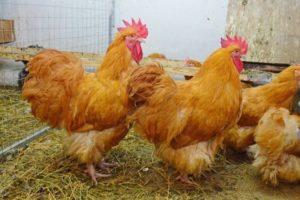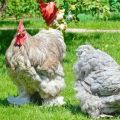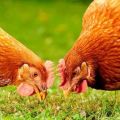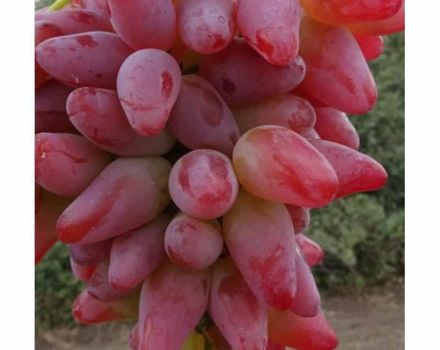Description and characteristics of the Andalusian blue breed of chickens, maintenance rules
Naturally, meat and egg indicators are the main characteristics of chickens that breeders pay attention to. However, birds that stand out for their outstanding exterior, plumage with original shades are also in demand. The Andalusian blue hybrid is always of interest. The breed becomes a real decoration of private farms and poultry farms.
History of origin
Thanks to the work of Spanish breeders, poultry farmers received Andalusian blue birds for breeding. This is the result of crossing blue fighting and black and white Minorca chickens. The result of the work is amazing: the chickens are distinguished by an exotic shade of plumage and good productivity. The decorative appearance of the bird is the main advantage, therefore layers are mainly used to decorate the poultry house.
Description and characteristics of the breed
To appreciate the breed of chickens, you need to take into account the conditions of their breeding, productive qualities.
Exterior and color of chickens
General view of the Andalusian blue bird: a long and strong body of graceful shapes, an elongated wide head with a large, single, upright crest (in chickens, the crest falls a little to one side). The long wings fit tightly to the sides. A broad, full, rounded chest stands out on the body.
Extraordinary color of plumage is a special advantage of the breed. The color of the feathers is black and blue (in roosters on the mane, back and lower back, feathers are darker than the general background). Approximate division of plumage by color palette: 50% blue feathers and 25% black and off-white. The contrasting combination of the comb, earrings of rich red color and black and gray plumage looks very bright and elegant.
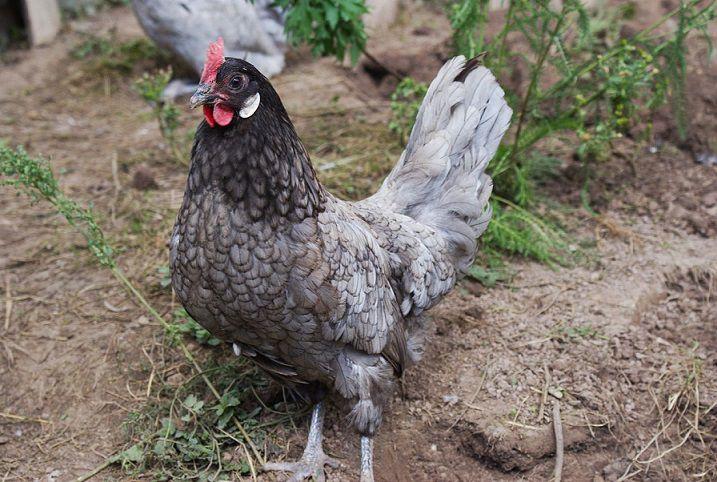
The disadvantages of the breed are the lack of a pattern on the plumage, an irregularly serrated ridge. Plumage discoloration (feathers that are too dark or too light) are also a deviation from the standard. An obvious marriage - a red bloom on the plumage, the presence of bright white feathers on the wings, tail.
Sexual maturity and productive qualities of Andalusian blue
Chickens of the Andalusian breed begin to lay at the age of 5-6 months (approximately 160 eggs per year, egg weight - 55-60 g). The meat qualities of individuals are average - a chicken weighs 2-2.2 kg, a rooster - 2.5-2.6 kg.
The nature of the birds
When breeding Andalusian blue, you need to take into account its quarrelsome disposition, especially when other birds appear.Chickens react quite calmly to their owners, but show aggression towards birds of other breeds. Stressful situations negatively affect the egg production of chickens, therefore it is recommended to keep different breeds in separate fenced areas.
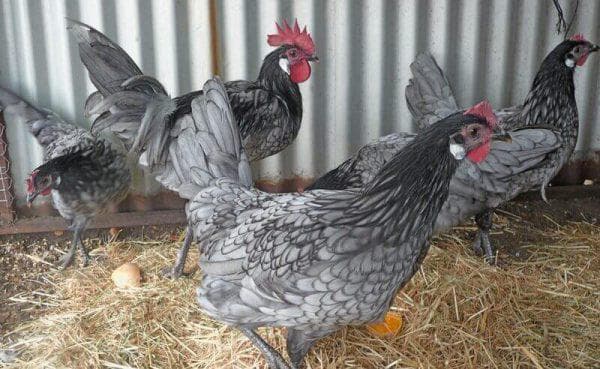
Main advantages and disadvantages
Like any breed of bird, the Andalusian blue chicken has positive and negative qualities. Main advantages:
- extraordinary appearance and original color of plumage;
- early maturation;
- grow well and develop in free content conditions;
- unpretentiousness in food.
Several drawbacks deserve attention:
- nestlings do not tend to hatch eggs;
- the bird flies well, so the grounds are fenced off with high nets / fences;
- noisy and somewhat aggressive behavior in the presence of other chicken breeds;
- does not tolerate low temperatures; in frosty weather, ridges and earrings quickly freeze over.
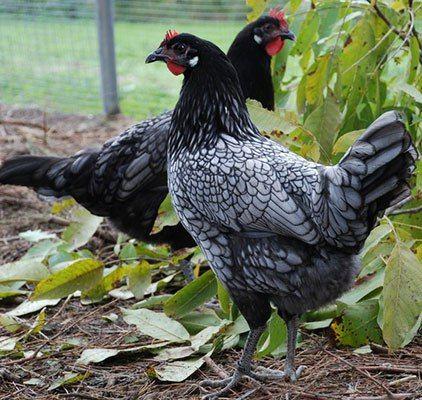
Maintenance and care
Like any poultry, Andalusian blue chickens need a warm indoor chicken coop and a walking area. It is strongly not recommended to constantly keep individuals in a closed space. In such conditions, without long walks and stay in the fresh air, chickens lose weight and egg production, and diseases appear.
House features
The place where the poultry is kept must meet certain requirements. Key points:
- no cracks, since drafts provoke the onset of diseases;
- sufficient area of the premises (at the rate of 3-4 birds per square meter). If the population is smaller, the chickens may freeze. And high density leads to a deterioration in ventilation and the appearance of diseases;
- it is recommended to protect the floor from rodents, therefore, use a sheet of sheet metal. Peat, straw or hay are suitable as bedding;
- small containers with wood ash or sand will allow the bird to comfortably clean feathers at any time.
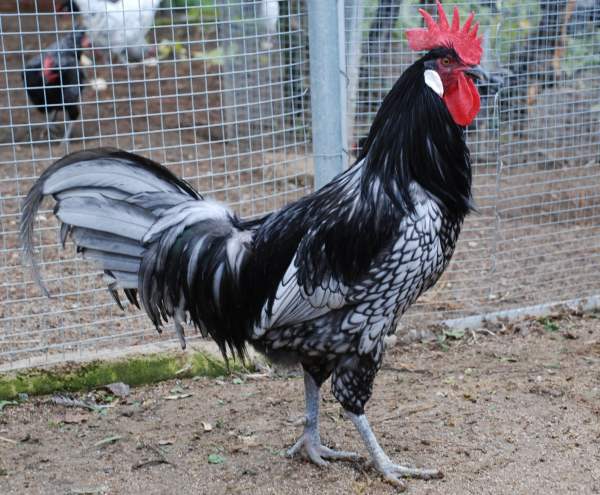
Important! The litter in the room is regularly changed, and the floor is treated with special disinfectants.
Perches are installed indoors. The perches are not fixed higher than 50 cm to prevent injury to birds in the event of a fall. It is not recommended to keep the Andalusian Blue breed without roosts, as the plumage and figure will deform in birds.
Lighting and ventilation in the chicken coop
Chickens require dim lighting for 11-12 hours. Therefore, the room is equipped with appropriate lighting. Easier to install "smart" lights that turn on automatically.
Advice! The poultry house is equipped with a ventilation system (built into the roof). Or the structure is complemented with window openings.
Walking yard
The presence of a specially equipped walking area is an ideal option for keeping Andalusian blue. The optimal solution is to install a manhole door from the chicken coop to the site. To provide the bird with protection from scorching sunlight or precipitation, a canopy is installed on the site.
Chickens easily fly over low fences. Therefore, the site is fenced off with a fence or mesh with a height of 2-2.5 m. In order for the walking area to be normally ventilated and illuminated, the territory is limited by a netting or nylon mesh. The canvases are carefully fixed to the supports.

Feeders and drinkers
Dry food can be poured into wooden containers - the volume of the container is important. The capacity is selected for the daily portion of the feed. Fix the feeders to the walls (at a level not higher than 0.5 m). If wet or mixed feed is used, then metal or plastic containers are chosen, since the feeders must be thoroughly cleaned and periodically disinfected.
Drinking bowls must be installed near the feeders, on the walking area. Birds drink a lot of water, especially young hens and chickens.You can buy factory feeding structures - bunker-type devices. Or breeders make devices with their own hands from auxiliary materials (plastic pipes, buckets, bottles).
How to feed the birds?
The Andalusian blue breed is unpretentious in nutrition. Feed must necessarily contain fiber, vitamins, carbohydrates, proteins for the full development of birds. When compiling a diet, it is recommended to take into account the age of the chickens.
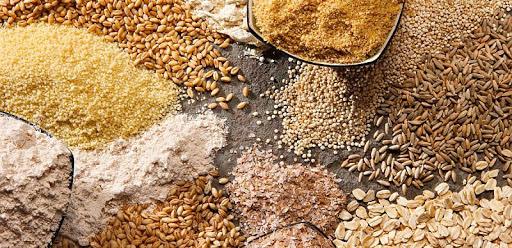
Chickens are mixed feed based on millet, barley and other finely ground cereals. Be sure to supplement the diet with cottage cheese, chopped boiled egg, ground herbs. By the age of one month, the chick should increase its weight by 250-300 g. Chickens older than two months are transferred to coarse feed mixtures intended for adult birds. For adult chickens, a wet mash is prepared based on cereals (oats, barley, peas, millet), with the addition of boiled vegetables (potatoes, beets, carrots). Summer ration must be enriched with chopped herbs 25-30 g per day. In winter, chalk, fish oil, bone meal are added to the feed mixtures.
Breeding chickens
Self-breeding of the breed is a troublesome business, since layers show poor maternal instinct. If there is no incubator, then they look after chickens capable of incubating eggs. Nesting is arranged in a warm, dark place. In this case, there should be free and easy access to the drinker and feeder. Nests are laid on a clutch of 4-6 eggs.
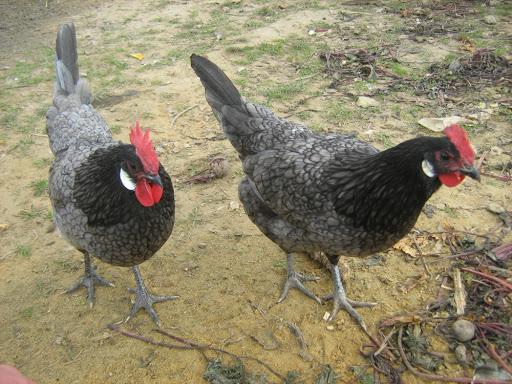
Diseases of the breed
When properly bred, blue chickens grow up with strong immunity to disease. The main danger for poultry is a cold that occurs during drafts, in conditions of damp and cold keeping. A suitable preventive measure is the grafting of young animals.
An unpleasant moment can be vitamin deficiency, which manifests itself during molting. A balanced diet with vitamin supplements will prevent the appearance of vitamin deficiency.
Most poultry farmers are engaged in breeding Andalusian blue chickens solely because of the exotic bird species. But at the same time, breeders note the pleasant taste of eggs and meat. Experienced farmers advise novice poultry breeders to purchase already grown young growth.
